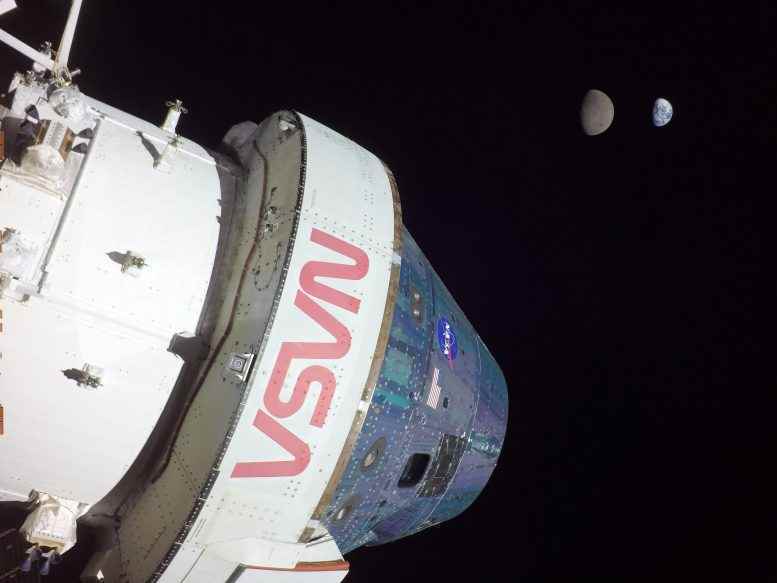13. uçuş gününde Orion, ana gezegenimizden 268.563 mil uzaktayken Artemis I görevi sırasında Dünya’dan maksimum mesafesine ulaştı. Orion artık insanlar için yapılmış diğer tüm uzay araçlarından daha uzağa gitti. Kredi bilgileri: NASA
NASA Artemis I – Uçuş Günü 13: Orion (Maksimum) Mesafeye Gidiyor
28 Kasım Pazartesi günü saat 15:00 CST’den hemen sonra,[{” attribute=””>NASA’s uncrewed Orion spacecraft reached the farthest distance from Earth it will travel during the Artemis I mission — 268,563 miles (432,210 km) from our home planet. The spacecraft also captured imagery of Earth and the Moon together throughout the day, including of the Moon appearing to eclipse Earth.
Reaching the halfway point of the mission on Flight Day 13 of a 25.5 day mission, the spacecraft remains in healthy condition as it continues its journey in distant retrograde orbit, an approximately six-day leg of its larger mission thousands of miles beyond the Moon.
“Because of the unbelievable can-do spirit, Artemis I has had extraordinary success and has completed a series of history-making events,” said NASA Administrator Bill Nelson. “It’s incredible just how smoothly this mission has gone, but this is a test. That’s what we do – we test it and we stress it.”

Artemis I will be the first integrated flight test of NASA’s deep space exploration system: the Orion spacecraft, Space Launch System (SLS) rocket, and the ground systems at Kennedy Space Center in Cape Canaveral, Florida. Credit: NASA
Engineers had originally planned an orbital maintenance burn today. However, they determined it was not necessary because of Orion’s already precise trajectory in distant retrograde orbit. Based on Orion’s performance, managers are examining adding seven additional test objectives to further characterize the spacecraft’s thermal environment and propulsion system to reduce risk before flying future missions with crew. To date, flight controllers have accomplished or are in the process of completing 37.5% of the test objectives associated with the mission, with many remaining objectives set to be evaluated during entry, descent, splashdown, and recovery.
NASA’s Exploration Ground Systems team and the U.S. Navy are beginning initial operations for recovery of Orion when it splashes down in the Pacific Ocean. The team will deploy Tuesday for training at sea before return to shore to make final preparations ahead of splashdown.
13. uçuş gününde Orion, Dünya ve Ay’dan uzaklaşmaya devam ediyor ve saat 10:41 CST’de çekilen bu videoda ikisi tutulmaya başlarken ana gezegenimiz ve Ay komşumuza bakıyor. Kredi bilgileri: NASA
Yöneticiler ayrıca, donanımın beklendiği gibi performans gösterdiğini ve başlangıçta şüpheli okumaların uçuş ortamının bir yan ürünü olduğunu belirledikten sonra, uzay aracının yıldız izleyicileriyle ilişkili okumaları araştırma görevinde daha önce oluşturulmuş bir ekibi bugün kapattı.
Uçuş kontrolörleri ayrıca 19 öteleme yanığından 9’unu tamamladı ve üç tür uçuşu gerçekleştirdi. motorlar Orion’da – ana motor, yardımcı iticiler ve reaksiyon kontrol sistemi iticileri. Fırlatma öncesi beklenen değerlerden yaklaşık 150 pound daha az olan yaklaşık 5.640 pound itici gaz kullanıldı. Ekiplerin görev için kullanmayı planladıklarının ötesinde, lansman öncesi beklenen değerlerden 120 pound’dan fazla bir artışla 2.000 pound’dan fazla marj kaldı. Ekipler şimdiye kadar uzay aracından Dünya’ya 2.000’den fazla dosya gönderdi.
13. uçuş gününde Orion, Dünya’dan ve Ay’dan uzaklaşmaya devam ediyor ve Ay, Orion’dan görüldüğü gibi Dünya’yı tutmaya hazırlanırken ana gezegenimize ve ay komşumuza bakıyor. Kredi bilgileri: NASA
Saat 20:00 EST’den hemen önce Orion, Dünya’dan 268.457 mil (432.040 km) ve Ay’dan 43.138 mil (69.424 km) uzaklıktaydı ve saatte 1.679 mil (2.702 km) hızla seyrediyordu.
Görevi gerçek zamanlı olarak takip etmek için şunları yapabilirsiniz: Orion’u takip et Ay etrafındaki görevi sırasında ve geri dön ve izle canlı görüntü uzay gemisinden. kontrol et NASA TV programı Bir sonraki televizyon etkinlikleriyle ilgili güncellemeler için.

